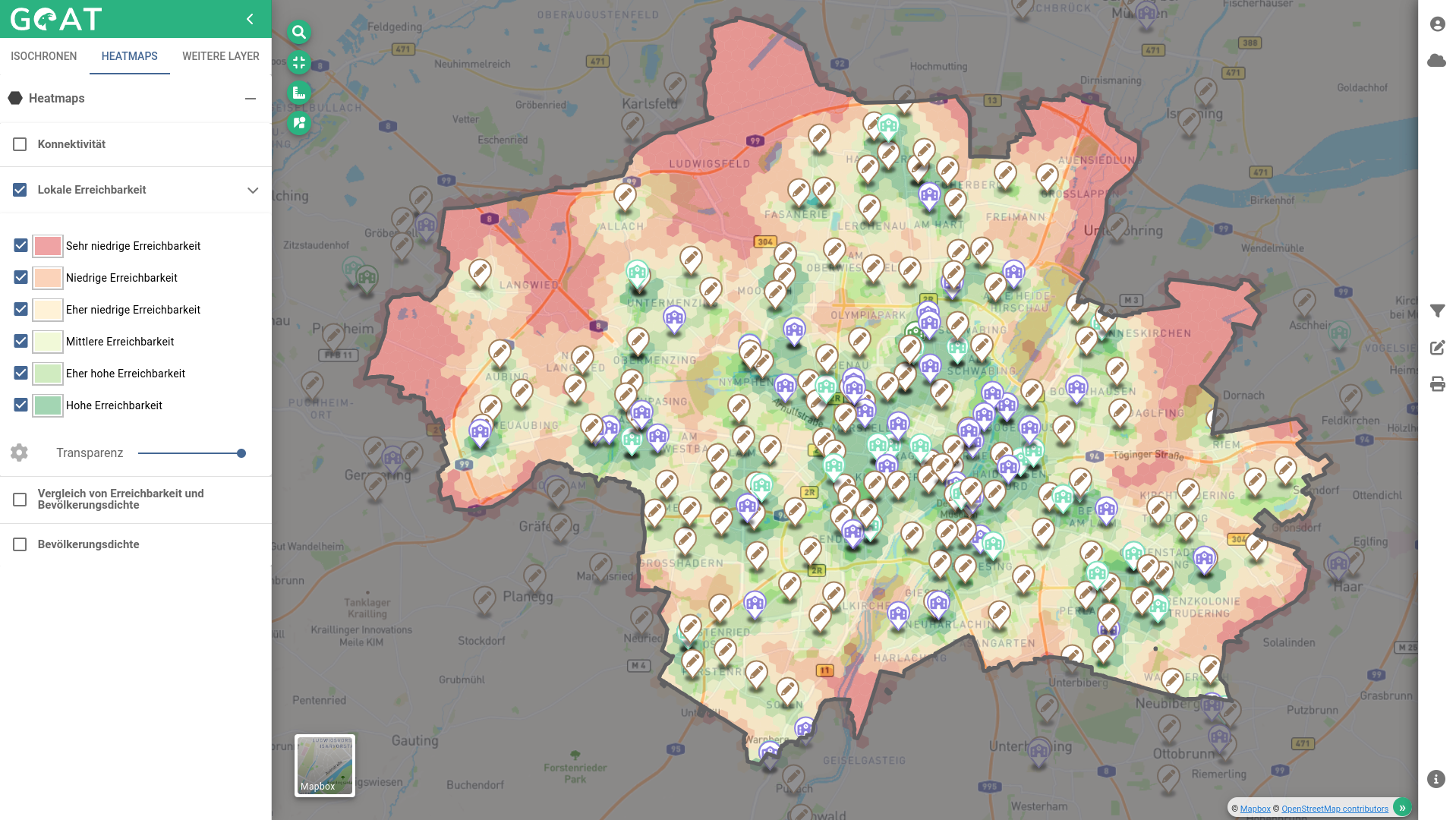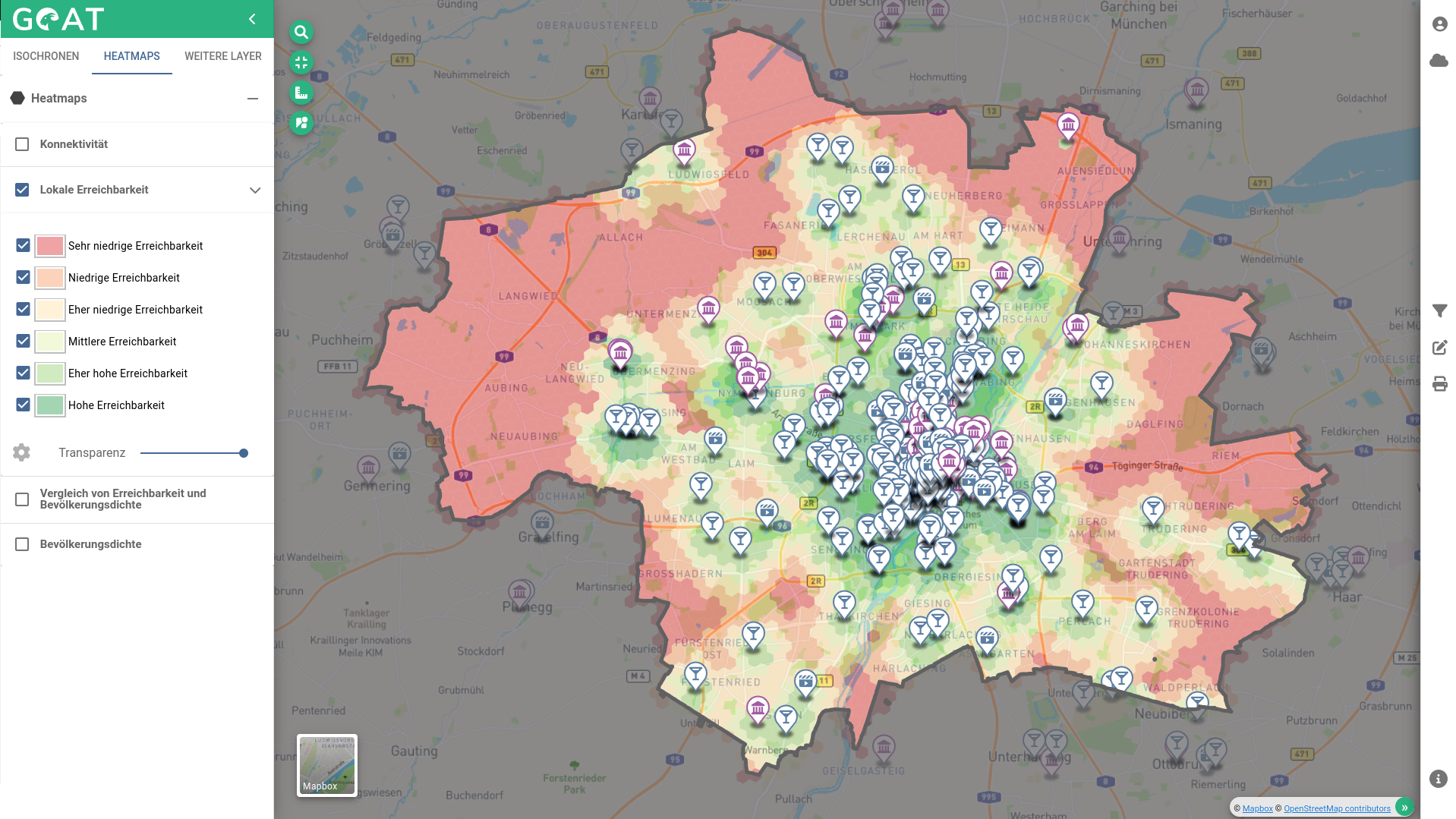What is the 15-minutes city?
Munich is currently pressed with issues of traffic congestion and housing shortages. The discussion on public transit, walking, and cycling is growing louder with every coming year (Landeshauptstadt München, 2022). We’d propose the 15-minute city as vision and inspiration to bring accessibility to the forefront for Munich’s future.
Carlos Moreno coined the term «15-minute city» in planning projects with the City of Paris, which has taken his idea as a source of inspiration for a lot of rapid change in the city (Moreno, 2019). This shift is adhering to the transition from a “mono-functional” city to a “polycentric” city based on proximity, diversity, density and ubiquity to bind and offer greater quality to six essential urban functions: living, working, supplying, caring, learning, and enjoying (Petzer, 2021).
The vision of the 15-minute city is that all residents can reach basic needs and services within 15 minutes on foot or by bicycle (and, as a complement, by public transport). The challenge for a planner is to identify current service gaps and find suitable locations for new services and improved walking and cycling infrastructure. As developers of the digital planning tool GOAT, we are here for you!
Sub-Centralities
Points of Interest (POIs) can be used as a great unit of measure for urban functional areas and urban ’vibrancy,’ given mixed-use areas are not easily covered by general land use designation (Yue et al., 2017). POIs have no standard definition but are generally places or facilities where human activity occurs (Chen et al., 2019). That is, restaurants, hairdressers, bakeries, clothing stores, pharmacies, schools, supermarkets, bars, gyms, etc. GOAT includes much of this data sourced from OpenStreetMap and others.
Urban vibrancy in our case, can be the level of “intensity of people’s concentration” (p. 660, Yue et al., 2017). Simply put, where the people want to go. Similarly, urban functional areas can be determined by the distribution and interrelation of POIs (Hu & Han, 2019). Identifying urban functional areas can help determine the starting point of construction as well as the process of development throughout the years (Hu & Han, 2019).
By looking at Munich through the lens of ‘sub-centralities’ a better analysis of the 15-minute city is achievable (Correa, Vergara-Perucich, & Aguirre-Nunez, 2020). Sub-centralities, in our case, take the form of designated districts within Munich. We chose the districts Giesing, Neuperlach, Sendling, Schwabing, and Moosach to compare the distribution of POIs across the district populations that fall within a 15-minute walking radius.

Image 1: 15-minute walking radius’ in districts Giesing, Neuperlach, Sendling, Schwabing, and Moosach
GOAT Analysis for Munich
GOAT offers helpful features to perform 15-minute city analyses. Image 2 shows the summarized results of the POI analysis per district. It shows how many destinations are each accessible within the 15 minute walking radius.

Image 2: Accessible destinations within 15 minutes
Schwabing takes the biggest slice of the cake in amenity distribution. Given Schwabing is one of the densest residential areas of the city, it also benefits from integrated mixed-use planning, with bars, restaurants, and other shops at street-level access. However, Giesing has a higher population count but four times less amenities than Schwabing. This poses a problem then, as residents from one district will likely need to travel outside of their district to find desired and needed amenities.

Image 3: Screenshot of School Accessibility in Munich

Image 4: Screenshot of Bars and other recreational activities in the city
Some POIs, especially those managed by the municipality, such as schools, are very well distributed across the city (Image 3). However, other POIs, such as bars and other recreational activities such as cinemas and museums, are distributed primarily within the inner city (Image 4).
The issue of uneven POI distribution can mean a lack of diverse options and may result in more mobility outside of districts, resulting in more cars on the road, and more people demanding better transport infrastructure. In order to achieve the 15-minute city status, a look at POI distribution throughout the city can assist us to target areas that could use improvements.
Is Munich 15-minute-city ready?
In summary, Munich has the potential to become a 15-minute city. Some districts are already “readier” than others.
The fact that near-by destinations in terms of the 15-minute city are part of the recently presented Mobility Strategy 2035 brings hope. The topic is on the agenda of the City of Munich and is to be tackled more intensively in the coming years. We are here to help with our planning software GOAT and are happy to provide support wherever possible!
Would you also like to make your city more liveable and turn the vision of the 15-minute city into reality? Then feel free to contact us!
References
Chen, Tingting, Hui, Eddice C.M., Wu, Jiemin, Lang, Wei, Li, Xun. (2019). Identifying urban spatial structure and urban vibrancy in highly dense cities using georeferenced social media data, Habitat International, Vol. 89, DOI: 10.1016/j.habitatint.2019.102005.
Correa Parra, Juan & Vergara Perucich, Francisco & Aguirre-Nuñez, Carlos. (2020). Towards a Walkable City: Principal Component Analysis for Defining Sub-Centralities in the Santiago Metropolitan Area. Land. 9. 362, DOI: 10.3390/land9100362.
Hu, Y. and Han, Y. (2019). Identification of Urban Functional Areas Based on POI Data: A Case Study of the Guangzhou Economic and Technological Development Zone. Sustainability, 11, 1385, DOI: 10.3390/su11051385
Hutter, Dominik. (2018). München droht der Verkehrskollaps. Süddeutsche Zeitung. Available online at https://www.sueddeutsche.de/muenchen/verkehrsueberlastung-muenchen-1.4243906, checked on 10/05/2022.
Landeshauptstadt München. (2022). “Erforderlicher ÖPNV im MVV-Raum zum Erreichen der Klimaschutzziele 2030.” München Unterwegs. Available online at https://muenchenunterwegs.de/angebote/klimagutachten-oepnv-grossraum-muenchen, checked on 10/05/2022
Moreno, Carlos. (2019). The 15 minutes-city: for a new chrono-urbanism! – Pr Carlos Moreno. Carlos Moreno. Available online at https://www.moreno-web.net/the-15-minutes-city-for-a-new-chrono-urbanism-pr-carlos-moreno/, checked on 10/05/2022.
Petzer, Brett. (2021). 15-minute city: A network of 15-minute neighbourhoods. Mobycon. Available online at https://mobycon.com/updates/15-minute-city-a-network-of-15-minute-neighbourhoods/, checked on 10/05/2022
Yue, Yang, Zhuang, Yan, Yeh, Anthony G. O.Yeh, Xie, Jin-Yun , Ma Cheng-Lin, & Li, Qing-Quan. (2017). Measurements of POI-based mixed use and their relationships with neighbourhood vibrancy, International Journal of Geographical Information Science, 31:4, 658-675, DOI: 10.1080/13658816.2016.1220561


